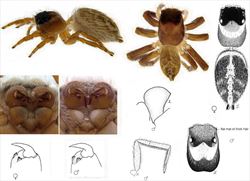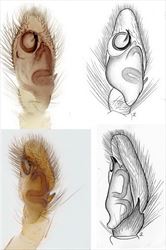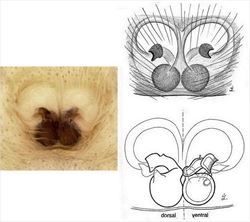
Examples of live Hypoblemum spp.
Illustrator (and ©) R. Whyte (BL), I.R. Macaulay

Aspects of the general morphology of Hypoblemum
Illustrators (and ©) B.J. Richardson (CSIRO) and M. Żabka (diag,) (QMB)

Palp morphology of Hypoblemum
Illustrators (and ©) B.J. Richardson (L) (CSIRO, M. Żabka (diag.) (QMB)

Epigyne morphology of Hypoblemum
Illustrators (and ©) B.J. Richardson (L) (CSIRO), M. Żabka (diag.) (QMB)
Hypoblemum Peckham & Peckham, 1886
Taxonomy
Hypoblemum currently includes two described species, Hypoblemum griseum from Australia and New Zealand and Hypoblemum scutulatum from Australia. The genus is part of a distinct group of Australian genera (Maddison et al 2008) related to the Old World genus Saitis (Zhang and Maddison 2015). Hypoblemum is closely related to Barraina, Jotus, Maratus, Prostheclina and Saratus; most nearly to Maratus (Otto, Hill & Whyte 2019). Further information on the genus and described species can be found in Richardson and Żabka (2017), Whyte and Anderson (2017) and Otto, Hill & Whyte (2019).
Description
Hypoblemum spp. are medium to large-sized spiders, body length 4.5 to 7.5mm, with an ovate to elongate-ovate abdomen. The head, viewed from above, is rectangular with the sides slightly curved, widest well behind the posterior lateral eyes. The carapace is high, rising to a peak at the posterior lateral eyes. Chelicerae have a single (unident) retromarginal tooth and one, two-pointed (fissident) promarginal tooth. In males of H. griseum the third pair of legs is longest and heavily fringed, the fourth pair second longest.
The male’s palpal tibia has a long retro-lateral tibial apophysis, crenulated on the inside margin. The tegulum is long with a large proximal lobe. The long, coiled embolus forms an anticlockwise three-quarter circle in the distal third of the tegulum, the tip resting in a recess on the front of the cymbium. Behind this is a shorter, sharply-pointed sclerotized projection.
The female has two epigynal atria with sclerotised guides. The copulatory openings are near the centres of the atria. The sclerotized insemination ducts form short lateral curves before joining the spermathecae on their anterior edges. The spermathecae are round and located within the margins of the atria close to the epigastric fold.
Biology
Hypoblemum spp. are found in litter and foliage in forests and woodlands throughout Australia in habitats ranging from alpine and tropical rainforest to semi-desert. They are extremely common in and around houses. Specimens of this genus have been used by Jackson and co-workers in behavioural studies.
Distribution
Originating in Australia, specimens have been collected in New Zealand and on Lord Howe Island as well as in all Australian States and the Australian Capital Territory.
References
Cross, F.R., Jackson, R.R., Pollard, S.D. & Walker, M.W. 2006. Influence of optical cues from conspecific females on escalation decisions during male-male interactions of jumping spiders. Behavioural Processes 73, 136-141.
Cross, F. R., Jackson, R.R., Pollard, S.D. & Walker, M.W. 2007. Cross-modality effects during male-male interactions of jumping spiders. Behavioural Processes 75, 290-296.
Otto, J.C. & Hill, D.E. 2012. Notes on Maratus Karsch 1878 and related jumping spiders from Australia, with five new species (Araneae: Salticidae: Euophryinae). Peckhamia 103.1, 1-81.
Otto, J. C., Hill, D. E. & Whyte, R. (2019). Australian jumping spiders of the genus Hypoblemum (Araneae: Salticidae: Euophryini). Peckhamia 180.1: 1-62.
Rainbow, W.J. 1920. Arachnida from Lord Howe and Norfolk Islands. Records of the South Australian Museum 1, 229-272.
Richardson, B.J. & Żabka, M. 2016. Salticidae. Arachnida: Araneomorphae. Canberra, Australian Faunal Directory. Australian Biological Resources Study, at https://biodiversity.org.au/afd/taxa/SALTICIDAE.
Whyte, R. & Anderson, G. 2017. A Field Guide to Spiders of Australia. CSIRO Publishing: Clayton.
Żabka, M. & Pollard, S.D. 2002. Salticidae (Arachnida: Araneae) of New Zealand: genus Hypoblemum Peckham and Peckham, 1886. Records of the Canterbury Museum 16, 64-72.
* The information sheet should be interpreted in the context of the associated diagrams and photographs. Diagrams explaining anatomical terms can be found in the ‘Salticidae’ pictures at the beginning of the list of genera.